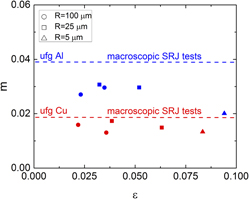Crossref Citations
This article has been cited by the following publications. This list is generated based on data provided by
Crossref.
Sudharshan Phani, Pardhasaradhi
and
Oliver, Warren
2017.
Ultra High Strain Rate Nanoindentation Testing.
Materials,
Vol. 10,
Issue. 6,
p.
663.
Gao, Chenghui
and
Liu, Ming
2017.
Power law creep of polycarbonate by Berkovich nanoindentation.
Materials Research Express,
Vol. 4,
Issue. 10,
p.
105302.
2017.
Errata.
Journal of Materials Research,
Vol. 32,
Issue. 12,
p.
2447.
Maier-Kiener, Verena
and
Durst, Karsten
2017.
Advanced Nanoindentation Testing for Studying Strain-Rate Sensitivity and Activation Volume.
JOM,
Vol. 69,
Issue. 11,
p.
2246.
Merle, B.
and
Höppel, H. W.
2018.
Microscale High-Cycle Fatigue Testing by Dynamic Micropillar Compression Using Continuous Stiffness Measurement.
Experimental Mechanics,
Vol. 58,
Issue. 3,
p.
465.
Gao, Chenghui
Yao, Ligang
and
Liu, Ming
2018.
Berkovich nanoindentation of borosilicate K9 glass.
Optical Engineering,
Vol. 57,
Issue. 03,
p.
1.
Leitner, A.
Maier-Kiener, V.
and
Kiener, D.
2018.
Essential refinements of spherical nanoindentation protocols for the reliable determination of mechanical flow curves.
Materials & Design,
Vol. 146,
Issue. ,
p.
69.
Feldner, P.
Merle, B.
and
Göken, M.
2018.
Superplastic deformation behavior of Zn-22% Al alloy investigated by nanoindentation at elevated temperatures.
Materials & Design,
Vol. 153,
Issue. ,
p.
71.
Meille, S.
Gallo, M.
Clément, P.
Tadier, S.
and
Chevalier, J.
2019.
Spherical instrumented indentation as a tool to characterize porous bioceramics and their resorption.
Journal of the European Ceramic Society,
Vol. 39,
Issue. 15,
p.
4459.
Böhm, Corinna F.
Feldner, Patrick
Merle, Benoit
and
Wolf, Stephan E.
2019.
Conical Nanoindentation Allows Azimuthally Independent Hardness Determination in Geological and Biogenic Minerals.
Materials,
Vol. 12,
Issue. 10,
p.
1630.
Merle, Benoit
Higgins, Wesley H.
and
Pharr, George M.
2019.
Critical issues in conducting constant strain rate nanoindentation tests at higher strain rates.
Journal of Materials Research,
Vol. 34,
Issue. 20,
p.
3495.
Merle, Benoit
Higgins, Wesley H.
and
Pharr, George M.
2020.
Extending the range of constant strain rate nanoindentation testing.
Journal of Materials Research,
Vol. 35,
Issue. 4,
p.
343.
Han, Jae-Kyung
Herndon, Taylor
Jang, Jae-il
Langdon, Terence G.
and
Kawasaki, Megumi
2020.
Synthesis of Hybrid Nanocrystalline Alloys by Mechanical Bonding through High‐Pressure Torsion.
Advanced Engineering Materials,
Vol. 22,
Issue. 4,
Daugela, Antanas
and
Daugela, Jurgis
2020.
Opto-nanomechanical test instrument in mechanical characterization of DLC coated MEMS devices.
Microsystem Technologies,
Vol. 26,
Issue. 11,
p.
3323.
Ebner, Anna Sophie
Brinckmann, Steffen
Plesiutschnig, Ernst
Clemens, Helmut
Pippan, Reinhard
and
Maier-Kiener, Verena
2020.
A Modified Electrochemical Nanoindentation Setup for Probing Hydrogen-Material Interaction Demonstrated on a Nickel-Based Alloy.
JOM,
Vol. 72,
Issue. 5,
p.
2020.
Feldner, Patrick
Merle, Benoit
and
Göken, Mathias
2021.
Breakdown of the superplastic deformation behavior of heterogeneous nanomaterials at small length scales.
Materials Research Letters,
Vol. 9,
Issue. 1,
p.
41.
Zhao, Facheng
Yeo, Alfred
Che, Faxing
Yang, Kai
Tian, Yujia
and
Zhou, Kun
2021.
A new method for the dynamic deformation characterization of thin-film stacked structures.
MRS Communications,
Vol. 11,
Issue. 6,
p.
917.
Golovin, Yu. I.
2021.
Nanoindentation and Mechanical Properties of Materials at Submicro- and Nanoscale Levels: Recent Results and Achievements.
Physics of the Solid State,
Vol. 63,
Issue. 1,
p.
1.
Schmalbach, Kevin M.
Lin, Albert C.
Bufford, Daniel C.
Wang, Chenguang
Sun, Changquan Calvin
and
Mara, Nathan A.
2021.
Nanomechanical mapping and strain rate sensitivity of microcrystalline cellulose.
Journal of Materials Research,
Vol. 36,
Issue. 11,
p.
2251.
Song, Peng
and
Spätig, Philippe
2022.
Effects of ball size and microstructures on indentation curves of Fe9Cr model alloys and tempered martensitic steel Eurofer97.
Nuclear Materials and Energy,
Vol. 30,
Issue. ,
p.
101143.






